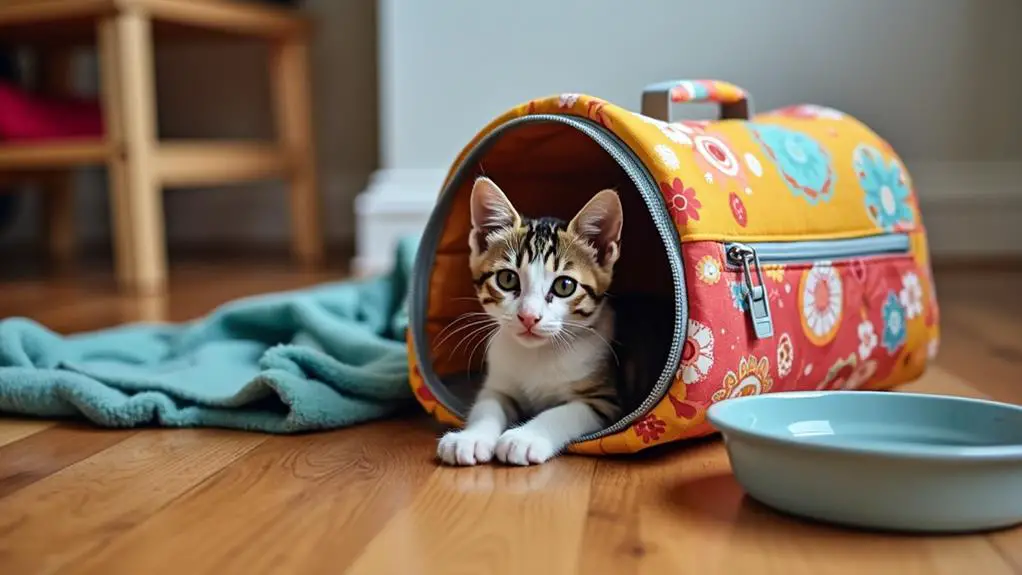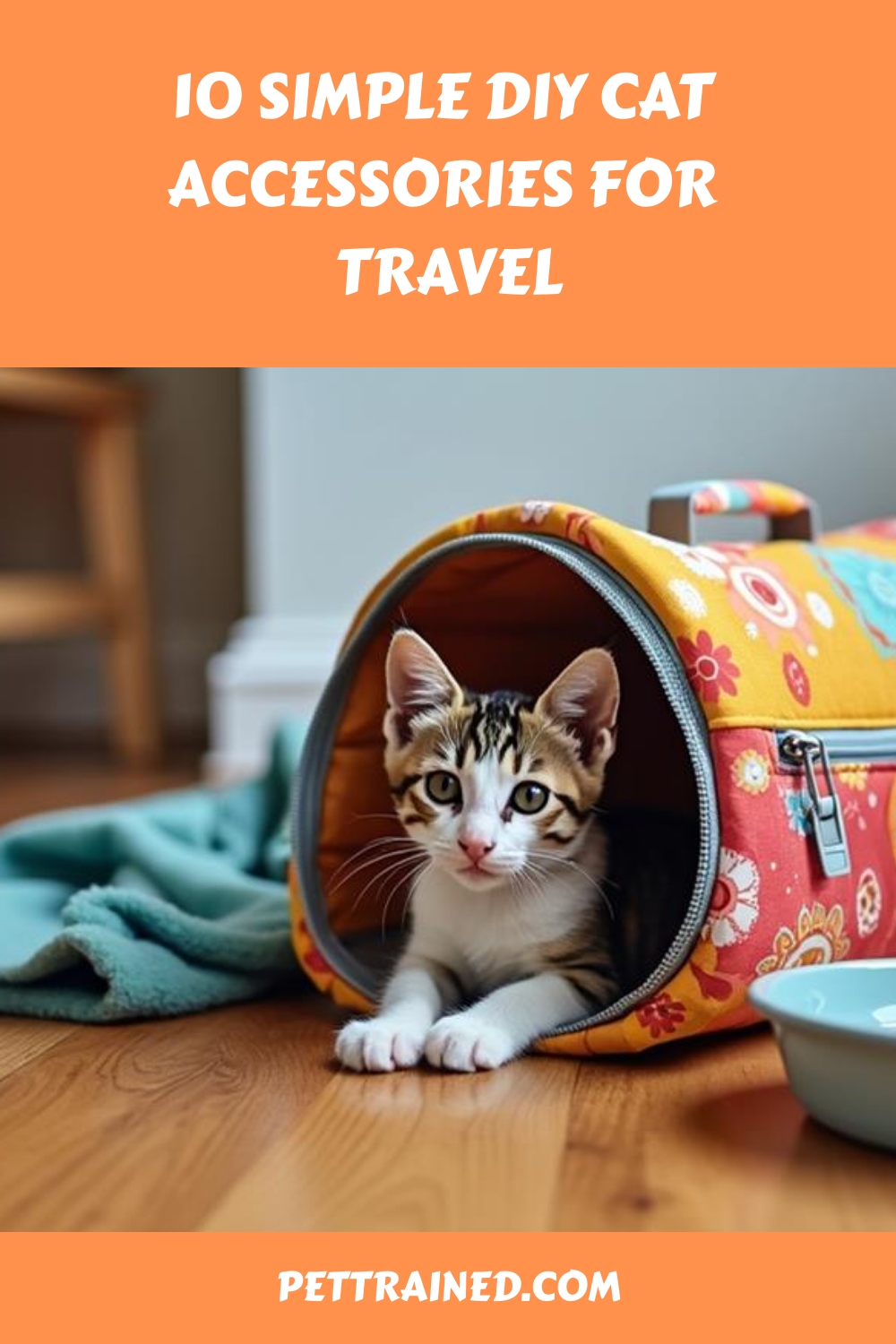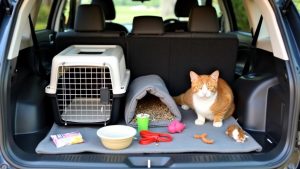Just as Odysseus prepared for his epic journey, you too can equip yourself for adventures with your feline companion. Traveling with cats doesn’t have to be a challenge when you’re armed with the right accessories. You’ll find that creating your own cat-friendly travel gear can be both cost-effective and tailored to your pet’s needs. From portable litter boxes to custom carriers, these DIY solutions offer comfort and convenience on the road. But there’s more to reflect upon than just the basics. What other innovative ideas might make your cat’s travel experience purr-fect?
Table of Contents
Portable Litter Box
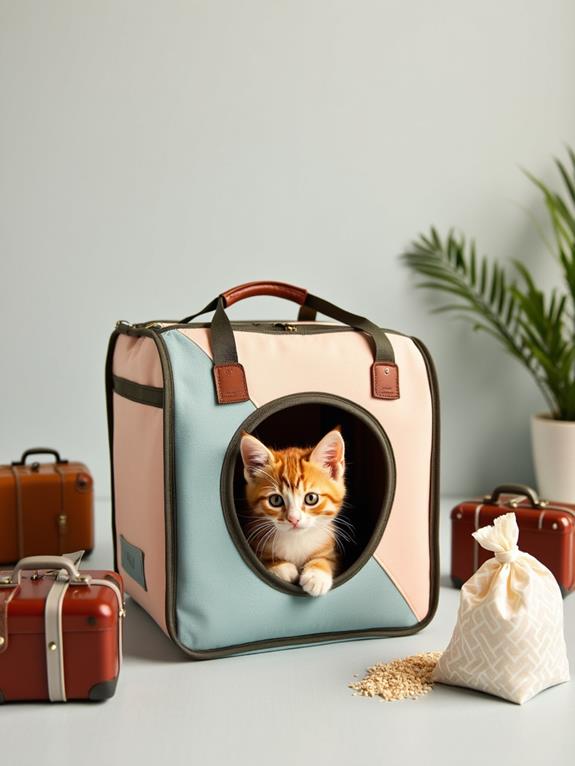
Crafting a portable litter box is essential for stress-free travel with your feline friend. To create one, start with a shallow plastic container with a lid. Confirm it’s large enough for your cat to comfortably use but small enough to fit in your vehicle.
Drill small holes in the lid for ventilation and to control odors. Top entry designs are particularly effective for reducing litter tracking during travel, similar to commercially available options.
For travel hygiene, line the bottom with a disposable puppy pad, which will absorb moisture and make cleanup easier. On top of this, add a thin layer of lightweight, clumping litter. This combination reduces mess and weight while maintaining familiarity for your cat.
Consider litter alternatives for travel, such as silica gel crystals or biodegradable options like pine pellets. These are often lighter and less dusty than traditional clay litters.
This post contains affiliate links. However all the information provided on this site are my own honest opinions. See more in Disclaimer.
Pack extra liners and litter in sealable bags for easy replacement during your trip.
To encourage use, place the box in a quiet, accessible spot in your vehicle or accommodations. Bring your cat’s usual litter scoop and waste bags for efficient cleaning.
Remember to clean the box frequently during travel to maintain hygiene and your cat’s comfort.
Collapsible Water Bowl
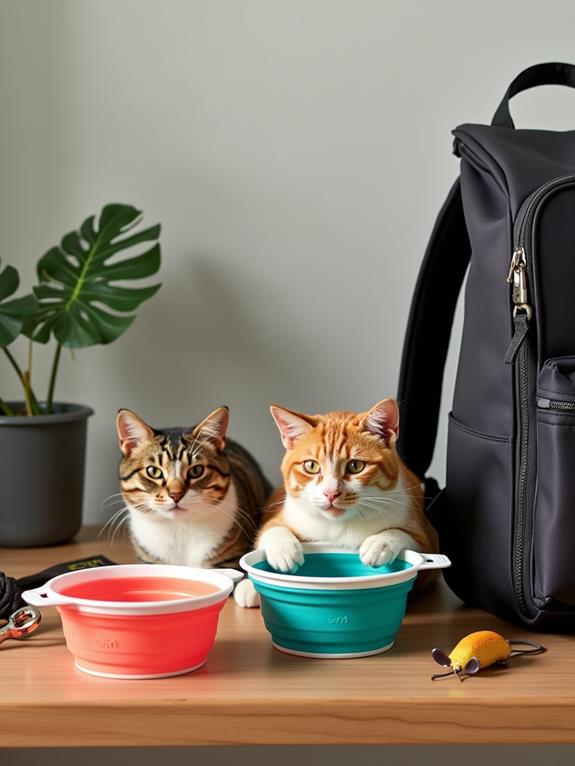
While a portable litter box guarantees your cat’s bathroom needs are met on the road, staying hydrated is equally important. A collapsible water bowl is an essential DIY accessory for your feline’s travel kit. You can easily create one using a plastic food container lid or a silicone baking cup. Simply fold the edges inward to form a shallow dish when needed, and flatten it for storage.
For a more durable option, consider using a thin, flexible cutting board. Cut it into a circular shape and score fold lines to create a bowl that pops up and collapses flat. Here’s a quick comparison of DIY collapsible bowl materials:
| Material | Durability | Weight | Ease of Cleaning |
|---|---|---|---|
| Plastic Lid | Low | Light | Easy |
| Silicone Cup | Medium | Light | Very Easy |
| Cutting Board | High | Medium | Moderate |
DIY Cat Carrier
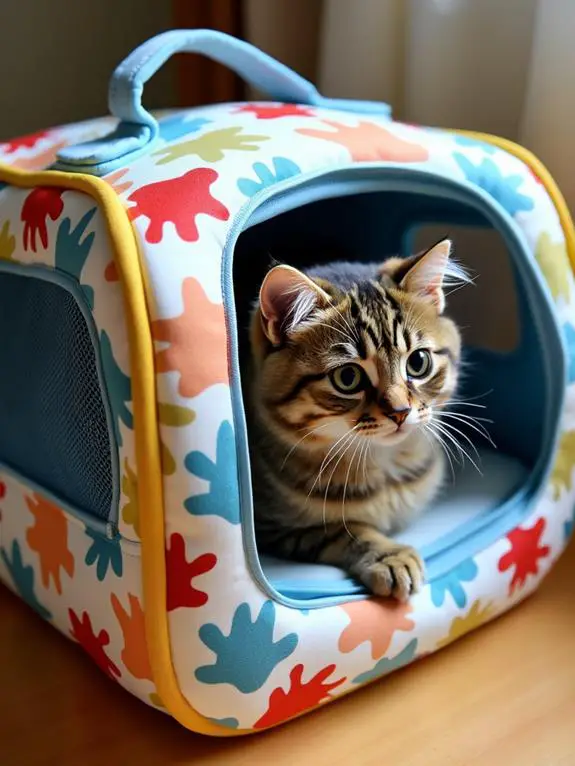
When it comes to transporting your feline friend, a DIY cat carrier can be both cost-effective and customizable to your cat’s needs. To create your own carrier, start by selecting durable cat carrier materials like sturdy cardboard, plastic storage containers, or even a repurposed suitcase. Confirm the chosen base is large enough for your cat to stand, turn around, and lie down comfortably.
While DIY options can be creative, it’s important to prioritize safety and comfort features similar to those found in commercial carriers, such as secure closures and adequate ventilation.
For a personalized carrier design, cut openings for ventilation and a door, then reinforce the edges with duct tape. Line the interior with a soft, washable fabric for comfort and easy cleaning. Add a secure latch mechanism to keep your cat safely inside during travel.
Consider your cat’s preferences when customizing the carrier. If they enjoy hiding, create a covered area within the carrier. For anxious cats, incorporate familiar scents by adding a piece of your clothing or their favorite blanket.
Don’t forget to include a small, spill-proof water dish and a designated space for treats or toys.
Travel-Friendly Scratching Post
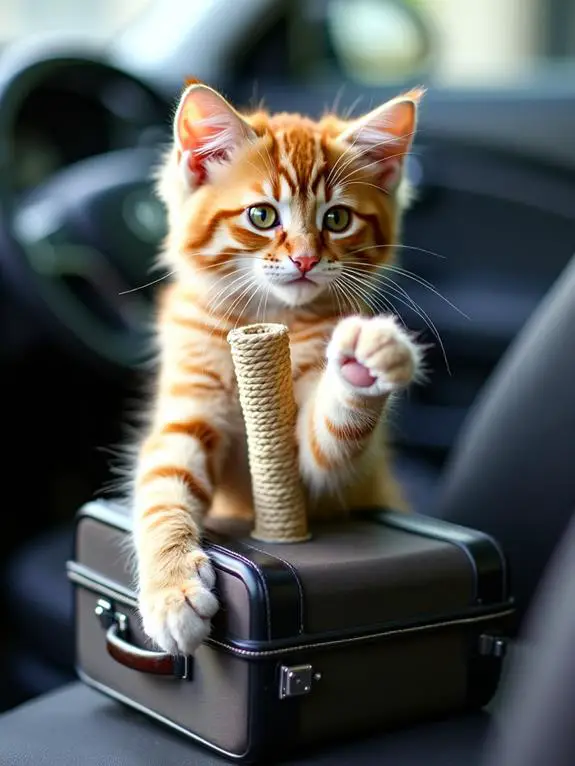
For the sake of your cat’s well-being during travel, a portable scratching post is vital. Cats need to scratch to maintain their claws and relieve stress, especially in unfamiliar environments. Creating a travel-friendly scratching post is simple and cost-effective.
Regular grooming and access to scratching surfaces are fundamental for maintaining your cat’s overall health and reducing shedding during your trip.
Start with a sturdy cardboard base, about 12 inches square. Cut strips of corrugated cardboard, each 2 inches wide, and stack them vertically on the base, securing with non-toxic glue. Wrap sisal rope tightly around the cardboard structure, leaving no gaps. This provides a satisfying texture for your cat’s claws.
For added portability, attach a folding mechanism using fabric hinges. This allows you to collapse the post flat for easy packing. Consider adding catnip to entice your feline friend.
As travel scratching alternatives, portable scratch pads made from compressed cardboard are lightweight and disposable. You can also create a mini scratching board using a small wooden plank covered with carpet or sisal.
Whichever option you choose, make sure it’s stable and won’t tip over during use. Regular access to these scratching surfaces will help keep your cat content and your furniture safe while traveling.
Homemade Cat Harness
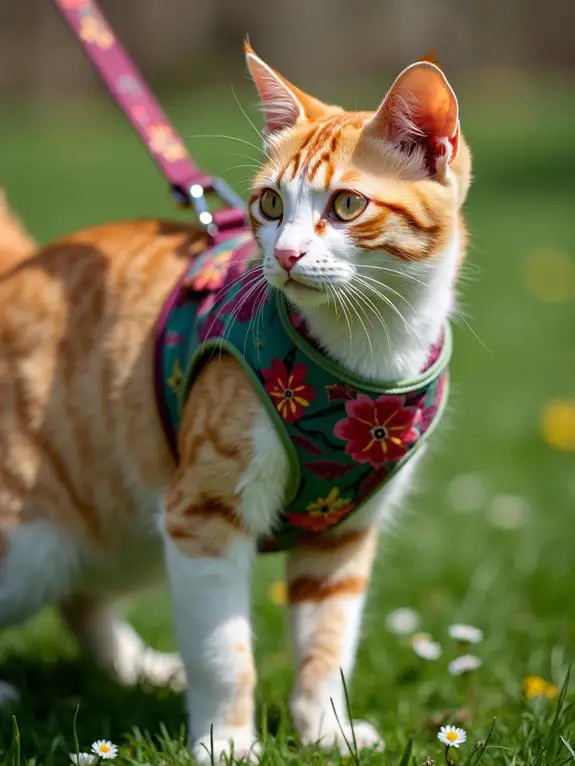
A well-fitted harness is essential for safely exploring new environments with your cat during travel. Creating a homemade cat harness guarantees a custom fit while saving money.
To start, you’ll need durable, cat-safe materials like nylon webbing, adjustable buckles, and soft fabric for padding. Similar to dog harness designs, consider incorporating breathable mesh material for your cat’s comfort during longer outings.
Measure your cat’s chest and neck circumference, adding an inch for comfort. Cut two pieces of webbing: one for the neck and one for the chest. Sew padding onto the inner side of the webbing for added comfort. Attach adjustable buckles to both ends of each strap.
Connect the neck and chest pieces with a short length of webbing on your cat’s back. This forms the basic H-shape of the harness. Confirm all seams are reinforced for cat safety. Test the fit by slipping two fingers between the harness and your cat’s body.
For extra security, add a small D-ring to attach a leash. Always supervise your cat when wearing the harness and remove it when not in use.
With your DIY cat harness, you’re ready to safely explore new destinations with your feline companion.
Compact Cat Bed
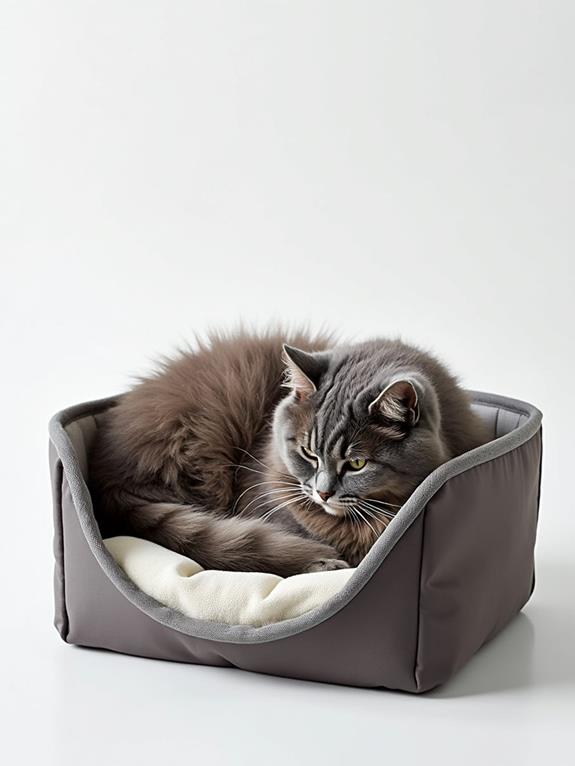
While traveling with your cat, a comfortable and familiar sleeping space is essential for their well-being. Creating a compact cat bed that’s easy to transport and set up will guarantee your feline friend feels secure in new environments.
To craft this portable haven, you’ll need some key cat bed materials: a soft, washable fabric, foam padding, and a non-slip base. Consider using eco-friendly materials similar to those found in high-quality pet beds for added sustainability and comfort.
Start by selecting a durable, lightweight fabric that’s easy to clean. Fleece or microfiber works well for cozy bed designs. Cut two circular pieces about 18 inches in diameter. Next, cut a long strip of fabric to form the sides, about 6 inches wide and long enough to fit around the circumference of your circles.
Sew the side strip to one of the circles, then attach the second circle to create a shallow cylindrical shape. Leave a small opening to insert the foam padding.
For added comfort, create a removable cushion using the same fabric and a thinner layer of foam. This allows for easy washing and replacement.
Car Window Perch
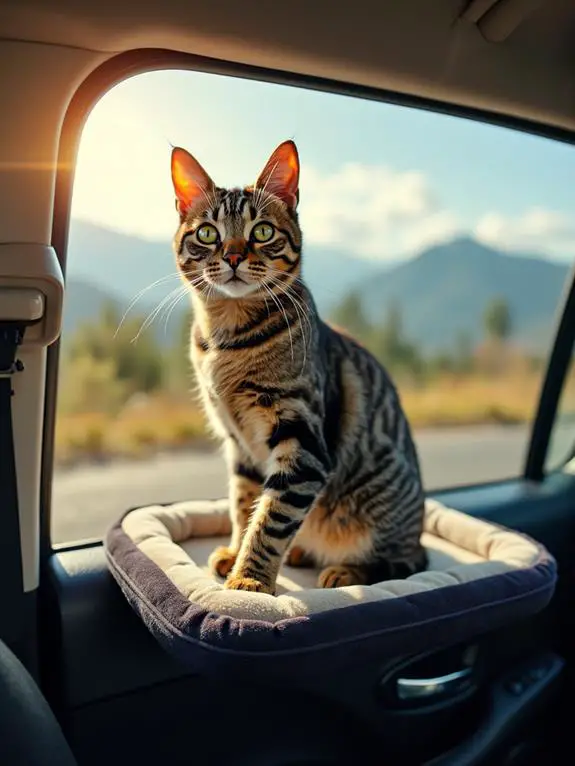
Cats love to observe their surroundings, and a car window perch gives them the perfect vantage point during road trips. This DIY accessory combines cat safety with travel comfort, ensuring your feline friend stays secure while enjoying the view.
To create a car window perch, you’ll need:
Trending in Cats:
- A sturdy platform (like a small wooden shelf or thick plastic board)
- Suction cups with hooks
- Soft, washable fabric for covering
Start by cutting the platform to fit your car’s window dimensions. Sand any rough edges to prevent injury. Drill holes near the corners to attach the suction cups. Cover the platform with fabric, securing it tightly underneath. Attach the suction cups, ensuring they’re strong enough to support your cat’s weight.
When installing the perch, clean the window thoroughly and moisten the suction cups for a firm grip. Position it at a comfortable height for your cat.
Always test the perch’s stability before letting your cat use it. For added safety, consider attaching a short leash from your cat’s harness to a secure point in the car. This DIY perch provides a cozy spot for your cat to relax and enjoy the journey.
Portable Toy Kit
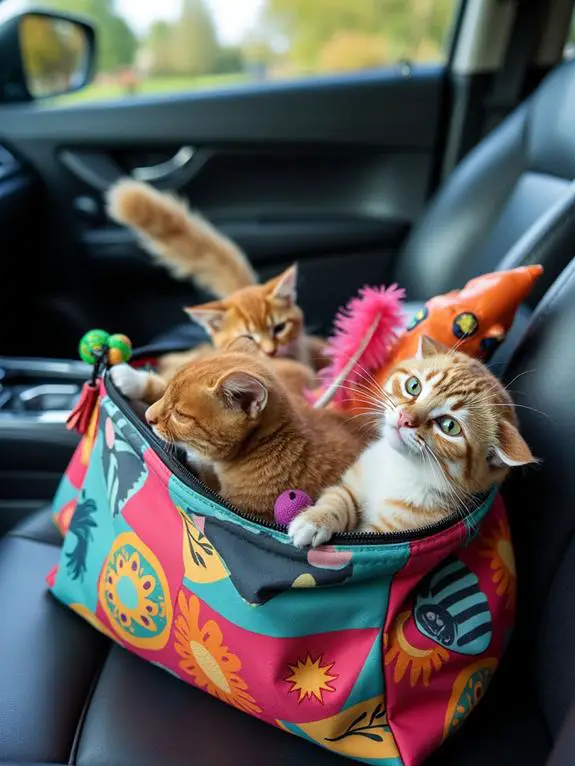
Creating a portable toy kit guarantees your feline friend stays entertained during travel, reducing stress and boredom. To craft this essential accessory, start with a small, zippered pouch or container for easy travel toy storage. Choose lightweight, compact toys that won’t take up much space but will keep your cat engaged.
While traditional toys are great, consider including a laser cat teaser for hands-free entertainment and to encourage natural hunting behaviors in a safe manner. Include a mix of interactive travel toys such as a collapsible wand toy, crinkle balls, and small plush mice.
Add a few catnip-filled toys for extra excitement, but use them sparingly to avoid overstimulation. Consider including a puzzle toy that dispenses treats, providing mental stimulation during long journeys.
Don’t forget to rotate the toys regularly to maintain your cat’s interest. Include a few new toys they haven’t seen before to spark curiosity. For safety, avoid toys with small parts that could be swallowed or strings that might cause entanglement.
When packing your portable toy kit, make certain all items are securely stored to prevent noise during travel. Keep the kit easily accessible so you can quickly grab a toy when your cat needs distraction or entertainment.
With a well-planned portable toy kit, you’ll have everything you need to keep your feline companion happy on the go.
Foldable Food Mat
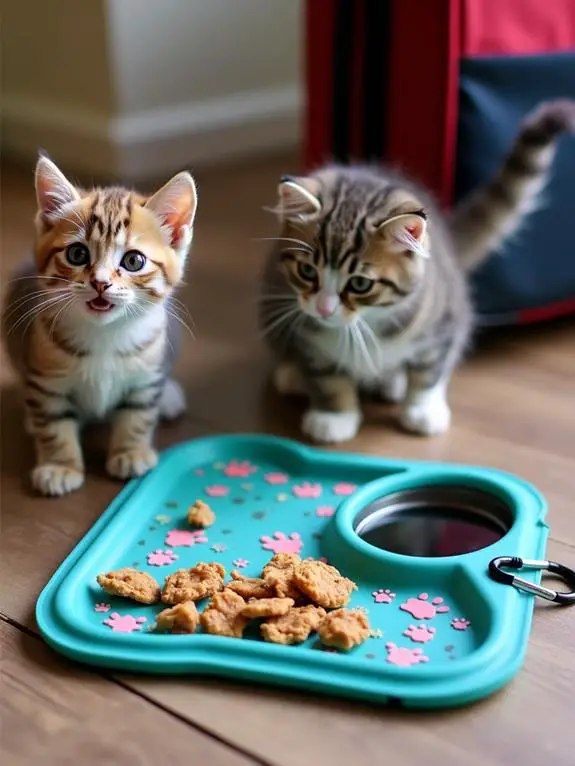
Why settle for messy mealtimes when you’re on the go with your feline friend? A foldable food mat is an essential DIY accessory for hassle-free cat food storage and convenient feeding during travel. This practical solution keeps your cat’s dining area clean and organized, no matter where your adventures take you.
Inspired by commercial options like the Always Hungry Anti-Slip mat, this DIY version offers a customizable and cost-effective alternative for pet owners.
To create your own foldable food mat, you’ll need:
- Waterproof fabric
- Scissors
- Sewing machine or fabric glue
- Velcro strips
Start by cutting a piece of waterproof fabric into a rectangular shape, about 18 inches by 24 inches. Fold and hem the edges to prevent fraying.
Next, sew or glue Velcro strips along the sides and bottom of the mat. This allows you to fold it into a compact pouch for easy storage and transport.
When it’s time to feed your cat, simply unfold the mat and place their food and water bowls on top. The waterproof material catches spills and crumbs, making cleanup a breeze.
After mealtime, wipe the mat clean, fold it up, and you’re ready to hit the road again. This DIY foldable food mat is a game-changer for travel feeding tips, ensuring your cat always has a clean, familiar dining spot.
Travel First Aid Kit
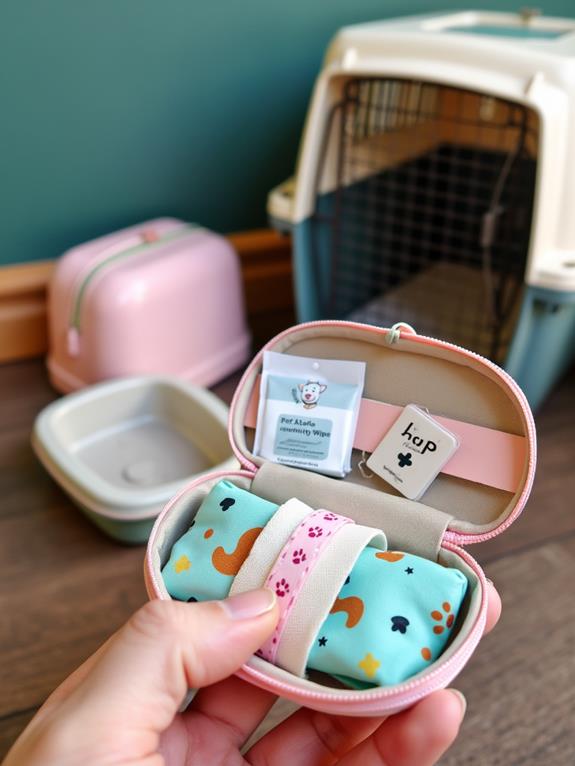
While a foldable food mat keeps your cat’s meals tidy on the road, you’ll also want to be prepared for unexpected health issues. A DIY travel first aid kit for your feline friend is essential for cat health and travel safety.
Start with a small, waterproof container that’s easy to pack. Include basic items like gauze pads, adhesive tape, scissors, tweezers, and a pet-safe antiseptic solution. For cats with respiratory issues, consider including respiratory relief litter samples to help manage symptoms during travel.
Don’t forget to pack any medications your cat regularly takes, along with a copy of their medical records. Add some oral syringes for administering liquids, and a few doses of a cat-specific probiotic for digestive issues.
Include a small bottle of pet-safe insect repellent and a tick removal tool for outdoor adventures. Throw in a few disposable heat packs for warmth in emergencies.
Lastly, add a list of emergency veterinary clinics along your travel route and your cat’s microchip information. By assembling this compact kit, you’ll be prepared to handle minor health issues and guarantee your cat’s safety during your travels.
Frequent Questions and Answers
How Can I Calm My Anxious Cat During Travel?
You’re not alone! Just like your cat, you might feel anxious during travel. Try cat calming techniques like pheromone sprays, soft music, or familiar toys. Cover their carrier and use travel anxiety remedies like herbal supplements or CBD oil.
What’s the Best Way to Secure a Cat in a Moving Vehicle?
When securing your cat in a moving vehicle, you’ve got two main options. Use a sturdy travel carrier, ensuring it’s fastened with a seatbelt. Alternatively, try a specially designed cat harness that attaches to your car’s safety restraints.
Are There Any Travel-Specific Cat Foods or Treats Recommended for Journeys?
Imagine you’re a sailor, stocking up for a voyage. For your feline first mate, you’ll want travel-friendly options. Pack nutritious treats like freeze-dried meat or kibble in single-serve pouches. You’ll keep your kitty content during the journey.
How Often Should I Schedule Breaks During Long Car Trips With Cats?
When traveling with cats, you’ll want to schedule breaks every 2-3 hours. This aligns with cat behavior tips and your travel preparation checklist. Offer water, litter box access, and a chance to stretch during these stops.
What Documents Do I Need When Traveling Internationally With My Cat?
Steering through the sea of international pet travel can be intimidating. You’ll need your cat’s up-to-date passport, including vaccination requirements and health certificates. Don’t forget microchip documentation and import permits for your destination country. Always check airline-specific rules too.
